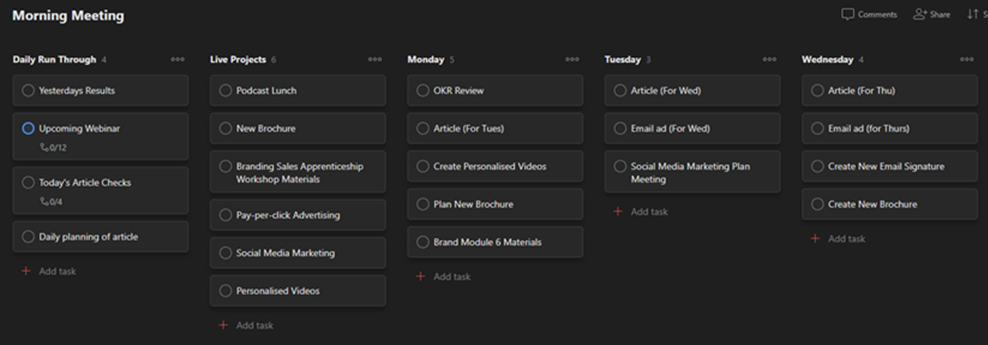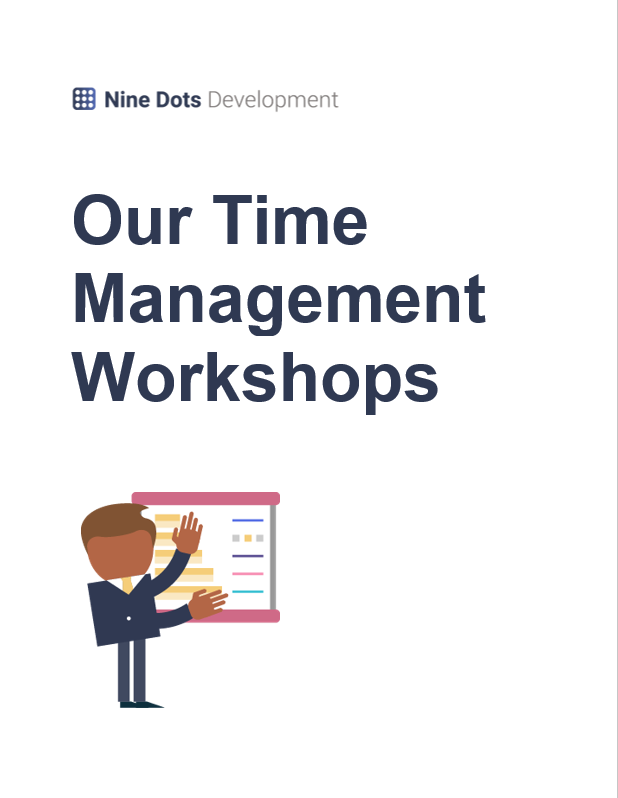Monday 20 Sep 2021 Article
The TakeawayA Simple Way to Encourage Better Time Hygiene in Your Organisation
Struggling with Time Management?
Part 1
#PrivateTraining #Time #Workload #TeamSuccess #ManagingManagers #AchieveMore
The perfectly matched resource for this article...
Our Time Management Workshops
Do you want to improve your staff’s time management skills? If so, professional time management training could be the perfect solution! We have collated all of our time and efficiency-related workshops into one PDF which you can download by clicking the button below.
Download!Playing catchup?
A Simple Way to Encourage Better Time Hygiene in Your Organisation
As mentioned in a previous article, time is a finite resource; once it’s gone, we can’t ever get it back, so it’s essential that employees use this precious commodity wisely.
In today’s article, we explore the importance of planning, how to plan long term, a simple way to encourage good daily use of time, and how you can improve your staff’s time management skills.
Why Planning Time Should Be Non-negotiable
The key to using time effectively is to plan it, both long and short term.
Planning provides clarity of what needs to be done, who by, and when, and helps ensure that the most important tasks are done first. If left to plan their time by themselves, staff may prioritise the tasks they enjoy even if they’re not the most important tasks currently on their plate. Collaborative planning also provides greater visibility of your employees’ workloads so that you can ensure that they don’t become unmanageable.
Helping staff plan their time is especially important for remote workforces. Often, when employees work remotely, they are left to their own devices and to manage their own time which can sometimes result in staff drifting away from the organisation’s mission and goals.

Making sure that your managers have regular discussions with all of their employees about both long and short term plans is vital to ensuring that their time is being well spent.
Planning for the Long Term
Long term planning sessions allow you to take a step back, look at the organisation’s overarching goals and then determine how these cascade down into individual departments, teams, and then employees. They also help prevent you from getting too caught up in day-to-day work and forgetting to consider the bigger picture.
- Time is similar to a budget; you have a set amount of time and you have to decide how you spend it, just how with a budget you have a set amount of money and you have to decide how you spend it. Instead of allocating tasks to employees, employees’ time should be allocated to tasks.
Having this clarity and awareness around upcoming tasks and projects makes allocating staff’s time much easier and more effective.
At Nine Dots, we use a goal-setting and planning strategy called OKRs (Objectives and Key Results).
OKRs were first invented and implemented by Andy Grove at Intel in 1971. Since then, countless organisations have adopted OKRs, including LinkedIn, Spotify, Twitter, BMW, Disney, Samsung, and most famously – Google. At Nine Dots, use 3-month long OKR cycles which are then broken down into what we want to achieve each month and each week, and we then plan this into our daily schedules.
To read more about exactly how OKRs work, the benefits, and how you can implement them in your organisation, please click here.
There are many different systems and programmes that you can use to plan both your own and your employees’ time - we personally use Todoist as it allows us to organise our work into different projects, assign tasks to individuals, and view our schedule on both a daily and weekly basis. Being able to visually see our workloads over a longer period of time means that it is less stressful when tasks come up unexpectedly as we can easily determine when we will have time to complete them. This is not only good for making sure that we have enough time to get things done, but also for employee wellbeing as it makes projects and workloads feel less overwhelming.
{{ADVERT}}
A Simple Way to Encourage Good Daily Use of Time
Leaders and managers can sometimes fall into the trap of forgetting that their employees may not have as much experience as they do and therefore might need more support with managing their time and workload, for example in the form of daily planning meetings.
At Nine Dots, we implemented daily planning meetings a while ago and have never looked back. Having these frequent meetings:
- Gives employees a chance to voice their concerns
- Allows managers to collaboratively plan their employees’ day
- Helps managers make sure that their employees’ workload for the day is manageable.
We call these discussions ‘Morning Meetings’, and we have a set agenda for them to make sure that nothing gets missed and we don’t waste time trying to think of everything that we need to discuss.
As we mentioned earlier on in this article, we use Todoist to plan our time. Within Todoist, we have a ‘Morning Meeting’ project that we refer to at the start of every day, for example:

This project is broken down into:
- Our daily run through
All of the tasks and responsibilities that we discuss every day. - Live and future projects
All of our long term projects, allowing us to keep an eye on their progress and catch any potential problems as early on as possible. - Each working day
We then have a section for every day, Monday to Friday, where we detail exactly what we will be doing each day and assign time to each task
When assigning time to tasks, it’s important to remember Parkinson’s Law which states that "work expands so as to fill the time available for its completion", meaning that however much time is allocated to a task, it will take up all of that time, so it’s crucial to make sure that your staff are allocating reasonable times to the tasks on their to-do lists. However, it’s also important to remind staff to leave contingency time in their schedules as tasks can sometimes take longer to complete than expected, especially for new projects.
At the end of every day, staff should reflect on how their day has gone, identify if there are any tasks that haven’t been completed, and prepare for the next day’s Morning Meeting.
Our Fantastic Experience with These Time Management Tactics
Since implementing OKRs and Morning Meetings, we still have the same amount of time as we had before but now we achieve a lot more. We used to catch up ‘every now and then’ whenever we had spare time and, whilst this seemed like the logical thing to do at the time as we wanted to allow staff to get through their large workloads as quickly as possible, it actually led to people working in silos, information not being communicated efficiently, and by not planning and deconstructing large tasks into smaller subtasks, it also left a lot of room for misinterpretation.
Now that we have more definition around what needs to be done and we follow a tried-and-tested way of planning time, we have seen a fantastic increase in staff productivity.
Want to Improve Your Staff’s Time Management?
As this article explains, time is a finite resource so it’s essential that employees use it wisely.
Do you want to improve your staff’s time management skills? If so, professional time management training could be the perfect solution.
Many of our training courses include workshops that each cover different elements of time management. To make getting started with looking for time management training for your staff much easier, we have collated all of our time and efficiency-related workshops into one PDF which you can download by clicking here.
---
Until next time...
Our Time Management Workshops
Do you want to improve your staff’s time management skills? If so, professional time management training could be the perfect solution! We have collated all of our time and efficiency-related workshops into one PDF which you can download by clicking the button below.
Download!Missed an article?
More from Struggling with Time Management?
